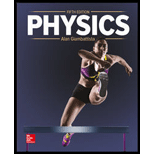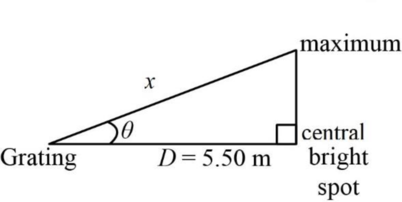
Concept explainers
(a)
The distance between the adjacent slits on the grating.
(a)
Answer to Problem 64P
The distance between the adjacent slits on the grating is
Explanation of Solution
The distance between adjacent slits is the reciprocal of the number of slits per unit length.
Write the equation for the distance between the adjacent slits.
Here,
Conclusion:
Substitute
Therefore, the distance between the adjacent slits on the grating is
(b)
The distance of the first-order maximum from the central bright spot on the screen.
(b)
Answer to Problem 64P
The distance of the first-order maximum from the central bright spot on the screen is
Explanation of Solution
Write the Bragg’s law.
Here,
Substitute
The arrangement is shown in figure 1.

Refer to figure 1 and write the expression for
Here,
Rewrite the above equation for
Put equation (III) in equation (IV).
Conclusion:
Substitute
Therefore, the distance of the first-order maximum from the central bright spot on the screen is
(c)
The distance of the second-order maximum from the central bright spot on the screen.
(c)
Answer to Problem 64P
The distance of the second-order maximum from the central bright spot on the screen is
Explanation of Solution
Substitute
Put equation (VI) in equation (IV).
Conclusion:
Substitute
Therefore, the distance of the second-order maximum from the central bright spot on the screen is
(d)
Whether it can be assumed that
(d)
Answer to Problem 64P
It cannot be assumed that
Explanation of Solution
The assumption
Rewrite equation (II) for
Conclusion:
Substitute
Substitute
From the calculations, it is clear that the values of
Therefore, it cannot be assumed that
Want to see more full solutions like this?
Chapter 25 Solutions
Physics
- Consider a single-slit diffraction pattern for =589 nm, projected on a screen that is 1.00 m from a slit of width 0.25 mm. How far from the center of the pattern are the centers of the first and second dark fringes?arrow_forwardFor 600-nm wavelength light and a slit separation of 0.12 mm, what are the angular positions of the first and third maxima in the double slit interference pattern?arrow_forwardMonochromatic light is incident on a pair of slits that are separated by 0.200 mm. The screen is 2.50 m away from the slits. a. If the distance between the central bright fringe and either of the adjacent bright fringes is 1.67 cm, find the wavelength of the incident light. b. At what angle does the next set of bright fringes appear?arrow_forward
- A Fraunhofer diffraction pattern is produced on a screen located 1.00 m from a single slit. If a light source of wavelength 5.00 107 m is used and the distance from the center of the central bright fringe to the first dark fringe is 5.00 103 m, what is the slit width? (a) 0.010 0 mm (b) 0.100 mm (c) 0.200 mm (d) 1.00 mm (e) 0.005 00 mmarrow_forwardA monochromatic light of unknown wavelength is incident on a slit of width 20 m. A diffraction pattern is seen at a screen 2.5 m away where the central maximum is spread over a distance of 10.0 cm. Find the wavelength.arrow_forwardA single slit of width 2100 nm is illuminated normally by a wave of wavelength 632.8 nm. Find the phase difference between waves from the top and one third from the bottom of the slit to a point on a screen at a horizontal distance of 2.0 m and vertical distance of 10.0 cm from the center.arrow_forward
- When a monochromatic light of wavelength 430 nm incident on a double slit of slit separation 5 m, there are 11 interference fringes in its central maximum. How many interference fringes will be in the central maximum of a light of wavelength 632.8 nm for the same double slit?arrow_forwardWhy is it much more difficult to see interference fringes for light reflected from a thick piece of glass than from a thin film? Would it be easier if monochromatic light were used?arrow_forwardRed light (wavelength 632.8 nm in air) from a Helium-Neon laser is incident on a single slit of width 0.05 mm. The entire apparatus is immersed in water of refractive index 1.333. Determine the angular width of the central peak.arrow_forward
- Show that the distribution of intensity in a double-slit pattern is given by Equation 36.9. Begin by assuming that the total magnitude of the electric field at point P on the screen in Figure 36.4 is the superposition of two waves, with electric field magnitudes E1=E0sintE2=E0sin(t+) The phase angle in in E2 is due to the extra path length traveled by the lower beam in Figure 36.4. Recall from Equation 33.27 that the intensity of light is proportional to the square of the amplitude of the electric field. In addition, the apparent intensity of the pattern is the time-averaged intensity of the electromagnetic wave. You will need to evaluate the integral of the square of the sine function over one period. Refer to Figure 32.5 for an easy way to perform this evaluation. You will also need the trigonometric identity sinA+sinB=2sin(A+B2)cos(AB2)arrow_forwardAn effect analogous to two-slit interference can occur with sound waves, instead of light. In an open field, two speakers placed 1.30 m apart are powered by a single-function generator producing sine waves at 1200-Hz frequency. A student walks along a line 12.5 m away and parallel to the line between the speakers. She hears an alternating pattern of loud and quiet, due to constructive and destructive interference. What is (a) the wavelength of this sound and (b) the distance between the central maximum and the first maximum (loud) position along this line?arrow_forwardAt what angle is the first-order maximum for 450-nm wavelength blue light falling on double slits separated by 0.0500 mm?arrow_forward
 Physics for Scientists and Engineers: Foundations...PhysicsISBN:9781133939146Author:Katz, Debora M.Publisher:Cengage Learning
Physics for Scientists and Engineers: Foundations...PhysicsISBN:9781133939146Author:Katz, Debora M.Publisher:Cengage Learning University Physics Volume 3PhysicsISBN:9781938168185Author:William Moebs, Jeff SannyPublisher:OpenStax
University Physics Volume 3PhysicsISBN:9781938168185Author:William Moebs, Jeff SannyPublisher:OpenStax Principles of Physics: A Calculus-Based TextPhysicsISBN:9781133104261Author:Raymond A. Serway, John W. JewettPublisher:Cengage Learning
Principles of Physics: A Calculus-Based TextPhysicsISBN:9781133104261Author:Raymond A. Serway, John W. JewettPublisher:Cengage Learning Physics for Scientists and EngineersPhysicsISBN:9781337553278Author:Raymond A. Serway, John W. JewettPublisher:Cengage Learning
Physics for Scientists and EngineersPhysicsISBN:9781337553278Author:Raymond A. Serway, John W. JewettPublisher:Cengage Learning Physics for Scientists and Engineers with Modern ...PhysicsISBN:9781337553292Author:Raymond A. Serway, John W. JewettPublisher:Cengage Learning
Physics for Scientists and Engineers with Modern ...PhysicsISBN:9781337553292Author:Raymond A. Serway, John W. JewettPublisher:Cengage Learning Glencoe Physics: Principles and Problems, Student...PhysicsISBN:9780078807213Author:Paul W. ZitzewitzPublisher:Glencoe/McGraw-Hill
Glencoe Physics: Principles and Problems, Student...PhysicsISBN:9780078807213Author:Paul W. ZitzewitzPublisher:Glencoe/McGraw-Hill





